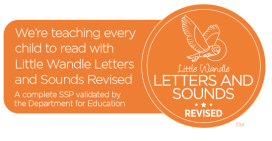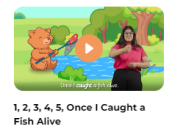Reading
Early Reading and Phonics
At The Walsh Schools we are passionate about reading and developing a love of reading for pleasure. We use the Little Wandle Phonics scheme to teach our children to read.
Phonics is an approach to teaching some aspects of literacy, by developing pupils’ knowledge and understanding of the relationship between written symbols and sounds. The aim is to systematically teach pupils the relationship between these sounds and the written spelling patterns, or graphemes, which represent them. Phonics emphasises the skills of decoding new words by sounding them out and combining or ‘blending’ the sound-spelling patterns.
We have chosen Little Wandle as it is a responsive programme which has inbuilt extra support for any of our learners who have gaps in their knowledge due to absence or illness, using ongoing assessments and the Keep Up and Catch up planning. In addition, Little Wandle SEND Programme has a graduated approach to teach children to learn to read in small steps that provide the right amount of challenge. It provides pathways for pupils who may need very specific adaptations to the teaching steps because they have complex needs, and has been developed with the advice from Special schools across the country.
Effective phonics techniques need to be embedded in a rich literacy environment for early and developing readers and are only one part of a successful literacy strategy. Little Wandle phonics programme supports The Walsh Schools encouragement of Reading for Pleasure through its focus on awe and wonder, and developing a love of reading. It offers support to match children’s secure phonic knowledge to the appropriate decodable reading books, in partnership with HarperCollins.
There are also accessible videos and downloads to support parents to encourage their child’s reading at home.
EYFS Phonics and Early Reading Presentation
Why learning to read is so important
- Reading is essential for all subject areas and improves life chances.
- Positive attitudes to reading and choosing to read have academic, social and emotional benefits for children.
How children learn to read
- Phonics is the only route to decoding.
- Learning to say the phonic sounds.
- By blending phonic sounds to read words.
- Increasing the child’s fluency in reading sounds, words and books.
Reading fully decodable books
- Children must read books consistent with their phonic knowledge.
- It is essential not to use other strategies to work out words (including guessing words, deducing meaning from pictures, grammar, context clues or whole word recognition).
- Books must be fully decodable and follow the Little Wandle scheme
- Children need to read books in a progressive sequence until they can decode unfamiliar words confidently.
The role of Parents’ and Carers’
- Have a positive impact on their child’s reading.
- Should model the importance of reading practice to develop fluency.
- Children take home books they have read at school to re-read at home to build fluency.
- There are two different types of books that pupils bring home: reading practice and books to share for pleasure.
- Reading at home encourages a love of books, along with developing vocabulary and discussion.
- Parents should use voices, expression, discuss unfamiliar vocabulary, talk about the pictures, and predict what might happen next.
- Give positive yet informative feedback in the home reading diary at least 3 times a week
Supporting your child with reading
Although your child will be taught to read at school, you can have a huge impact on their reading journey by continuing their practice at home.
There are two types of reading book that your child may bring home:
A reading practice book - This book has been carefully matched to your child’s current reading level and will be at the correct phonic stage for your child, they will have read this at least twice with their teacher. If your child is reading it with little help, please don’t worry that it’s too easy – your child needs to develop fluency and confidence in reading. Listen to them read the book. Remember to give them lots of praise – celebrate their success! If they can’t read a word, read it to them. After they have finished, talk about the book together.
A sharing book - Your child may able to read this on their own. This book is for you both to read and enjoy together. In order to encourage your child to become a lifelong reader, it is important that they learn to read for pleasure. They may be able to read this book or their own but the sharing book is a book they have chosen for you to enjoy together. Discuss the pictures, enjoy the story, predict what might happen next, use different voices for the characters, explore the facts in a non-fiction book. The main thing is that you have fun!
Programme Overview EYFS
Phase 2 sounds taught in Reception Autumn 1
This Phase 2 sounds taught in Reception Autumn 1 video is designed to be shared with families by schools using Little Wandle Letters and Sounds Revised
Phase 2 sounds taught in Reception Autumn 2
This Phase 2 sounds taught in Reception Autumn 2 video is designed to be shared with families to help them to support learning at home.
Phase 3 sounds taught in Reception Spring 1
This Phase 3 sounds taught in Reception Spring 1 video is designed to be shared with families to help them support the learning at home.
How we teach blending
This How we teach blending video is designed to be shared with families by schools using Little Wandle Letters and Sounds Revised to help them to support learning to blend
Quick guide to Alien words
This Alien words video is designed to be shared with families by schools using the Little Wandle Letters and Sounds Revised complete phonics programme
How we teach tricky words
This explanation of tricky words video is designed to be shared with families by schools using the Little Wandle Letters and Sounds Revised complete phonics programme
Resources for home
Glossary of terms
Grapheme Mats Phase 2 and 3
Grapheme Mats Phase 2, 3 and 5
Handwriting and pronuciation
Pronuciation guide - Reception Autumn 1 - Phase 2
Pronunciation guide Reception Autumn 2 - Phase 2
Pronunciation guide Reception Spring term - Phase 3
Link to Little Wandle Nursery Rhyme Videos

